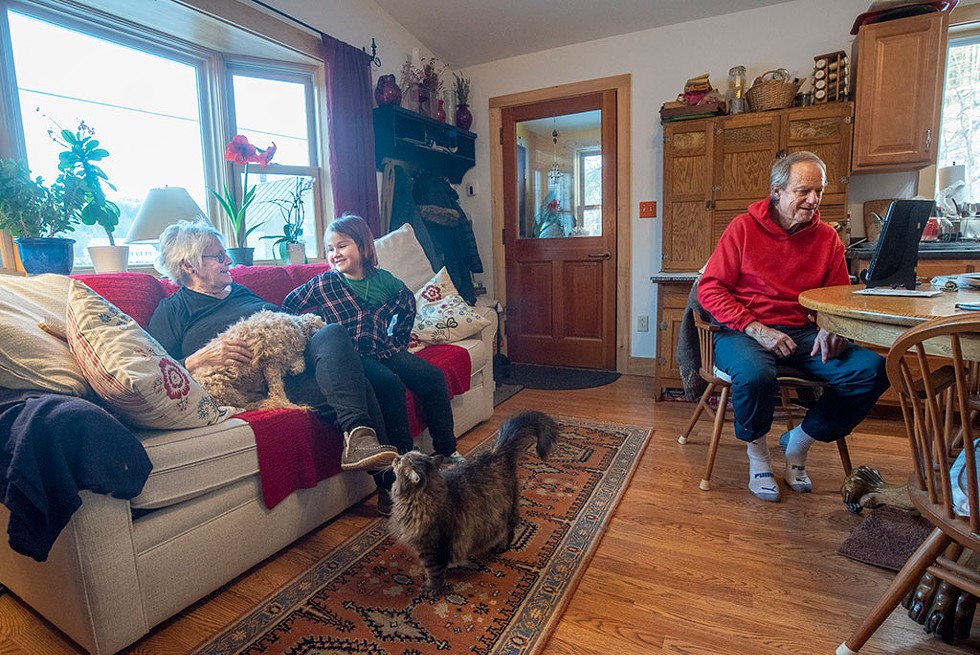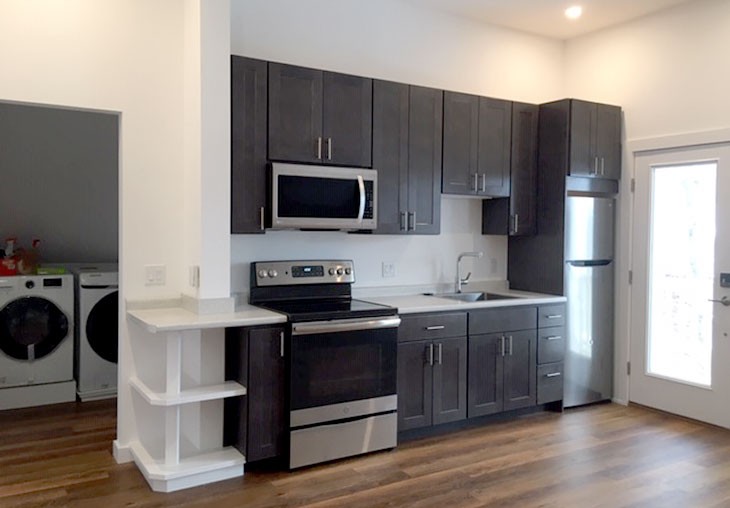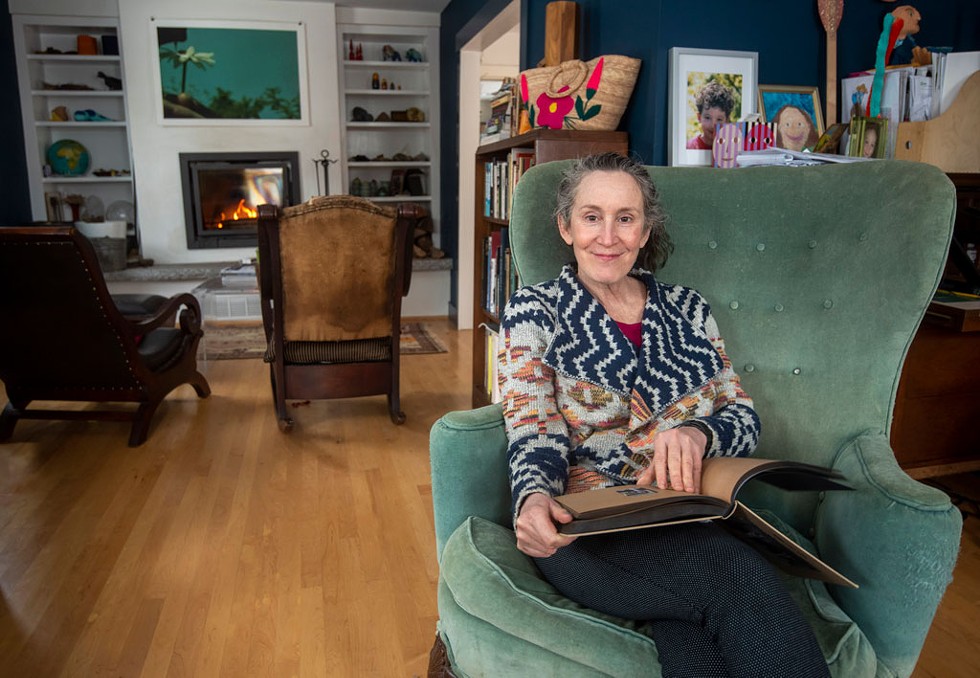
- Jeb Wallace-Brodeur
- Jean Lowell and Michael Gulick with granddaughter, Aquilla, 9, and their cat, Akira, and dog, Taffy
Finding affordable and accessible housing in Vermont isn’t easy. A recent search on housingdata.org, a site powered by the Vermont Housing Finance Agency, found fewer than 100 vacant rental units considered “affordable” in the entire state. In the first quarter of 2022, Vermont’s rental vacancy rate was the lowest in the country.
A few years ago, Jean Lowell wanted to help her daughter and granddaughter find a place near hers in Montpelier. Lowell also realized that, as she and her husband got older, they might need single-level housing that could accommodate a wheelchair.
After studying her two-story, three-bedroom home, and researching possible solutions, Lowell discovered that the smartest thing to do would be to add an accessory dwelling unit or ADU to her house — “what used to be called a mother-in-law apartment,” Lowell explained. It would be a big investment, but a state program incentivizing Montpelier property owners to create ADUs could help.

- Jeb Wallace-Brodeur
- Jean Lowell and her husband live in the single-level addition (left) they built with housing grants. Their daughter and granddaughter live in the main house (right).
Lowell applied to the program before the pandemic and received a $20,000 grant and a $10,000 no-interest loan to help pay for roughly $100,000 in construction costs. She was able to build a 600-square-foot single-level unit attached to the main house, which was finished in the fall of 2020. Her daughter and granddaughter moved to the main house, and she and her husband, both in their 70s, relocated to the new one. “It’s very cozy,” she said, “but it works.”
The state incentive program helped make it possible. “It wasn’t easy,” said Lowell, “but I feel secure in my old age. That makes it worth it.”
A mile away, Montpelier homeowner Marni Leikin used the same program to build a one-bedroom ADU above the carriage barn in her yard. She and her son live in a three-bedroom house on the property; the rent from her tenant, a NECI-trained chef who works in Waterbury, helps pay the mortgage.
Leikin had wanted to turn the carriage barn space into an apartment after she bought the place in 2013. She had even sketched out plans and brought plumbing and electricity into the barn with an apartment in mind, but the space sat vacant for years because she couldn’t afford to finish the job — until she discovered the incentive program.

- Jeb Wallace-Brodeur
- Marni Leikin in front of her Montpelier home. She built a one-bedroom ADU above the carriage barn in her backyard (see background).
Using it was “a total no-brainer,” she said. “I asked my accountant whether I should do it, and he was like, ‘you never say no to free money,’” she recalled.
Want to learn more about Vermont's ADU incentive programs?
ADUs like Lowell and Leikin’s are currently a “hot topic” in housing policy circles, according to Shaun Gilpin, Housing Division Director of Vermont Department of Housing and Community Development. Incentivizing homeowners to build them is a way to increase housing capacity, avoid sprawl and help seniors age in place in their communities. ”It’s a very smart-growth way to address our housing needs,” he said.
To create more of these success stories, Vermont has doubled down on its ADU incentives and expanded them across the state. Using $25 million from the American Rescue Plan Act, the housing and community development department has upped the ADU construction cost reimbursement to $50,000. Gov. Phil Scott has proposed a $15 million boost for the program in his 2023 budget.
In other words, if you’ve been thinking about adding an ADU to your property, now’s the time to do it.
How the ADU incentive works

- Jeb Wallace-Brodeur
- Jean Lowell and Michael Gulick's ADU: The entranceway, bedroom with a view of open-concept living room/kitchen, shower
The ADU incentive is part of the Vermont Housing Improvement Program. Since September 2020, VHIP has provided funds to help landlords repair and improve vacant apartments to make them habitable again.
Said Gilpin: “It’s a pretty low-barrier program, for sure.”
The new ADU grants, which target homeowners who aren’t yet landlords, carry fewer restrictions than other VHIP units. Applicants are only required to rent units at affordable rates for five years.
There are still a few hoops to jump through, though. To be eligible for the ADU incentive:
- The project must create a new unit of long-term rental housing — it can’t be listed on short-term rental sites like VRBO or Airbnb.
- The owner must live on the property.
- The unit must meet applicable housing codes.
- For at least five years, the ADU must be rented at Fair Market Rent as determined by the Housing and Urban Development Department. In 2023, for a one-bedroom, this ranges from $746 to $1238 depending on the county.
That was true of the ADU program Lowell used, too. She and her husband did “a tremendous amount” of the work on their unit, she said. “He and I did all the painting, all the sanding, and finish work.” They left the electricity and plumbing to the pros, though.

- Courtesy
- The kitchen and laundry room inside Marni Leikin's carriage barn ADU
Leikin, who grew up in Waitsfield, pointed out that Vermonters are often tempted to do home improvement projects themselves, but participating in the ADU program means that you have to rely on professionals. That includes starting with drawings from an architect or a design-build firm, and getting an estimate for how much the project will cost. “Everything has to be super above board,” she said.
Leikin and Lowell also noted that there were a few hiccups in the construction and permitting process, particularly around water and sewer hookups. “That required some extra work, and some extra fees,” Leikin said.
The ADU funds flow through five regional homeownership centers, and Gilpin said applicants can work closely with those organizations to understand and troubleshoot these kinds of issues. His department is also working to streamline the process to make it as easy as possible.
‘Don’t be afraid to do it’

- Jeb Wallace-Brodeur
- Marni Leikin
Both Leikin and Lowell recommend participating in ADU incentive programs wholeheartedly — Lowell calls it “a fantastic program.” Neither of them would have been able to add their units without it.
Leikin urges more Vermonters to consider adding an ADU. “Don’t be afraid to do it,” she said. “Don’t be afraid to live close to other people.” She said she’s heard Vermonters express hesitation about sharing their property with tenants, but she’s found that it’s really not an issue. She and her son rarely bump into Max, their renter. The same was true of the basement apartment she rented out for years in her last house in Washington, D.C.
Want to learn more about Vermont's ADU incentive programs?
She also noted that there’s no shortage of people looking for housing. She advertises her place online and does her due diligence when people apply, which includes a credit and reference check. “It’s never been a problem to find really good people,” she said.
Leikin chose to live in Montpelier because it’s a walkable community; her son was able to walk to elementary and middle school, and go downtown on his own. She can do many of her errands on foot. “There are some weeks when I never take my car out,” she said.
By creating another housing unit in her neighborhood, she’s made it possible for someone else to enjoy that community, too — Max confirmed that’s something he likes about living in Montpelier.
Leikin pointed out that, before she turned Max’s place into an apartment, “we weren’t even using that space.” Now, thanks to the ADU incentive, it’s someone’s home.
To apply for funding through the ADU program, contact your local homeownership center:
- RuralEdge in Caledonia, Essex, and Orleans counties
- Champlain Housing Trust in Chittenden, Franklin and Grand Isle counties
- NeighborWorks of Western Vermont in Addison, Bennington and Rutland counties
- Downstreet Housing & Community Development in Lamoille, Orange and Washington counties
- Windham & Windsor Housing Trust in Windham and Windsor counties
